Identification GR 1999,0426.1 | Material Silver Created Roman, 5–15 CE | |
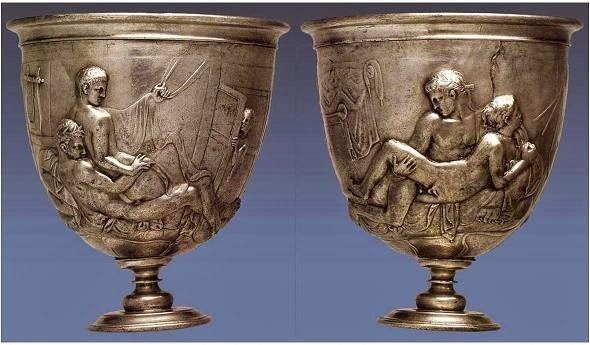 | ||
Size height:11 cm (4.3 in), width:9.9 cm (3.9 in) (max.), depth:11 cm (4.3 in) Similar | ||
Warren cup
The Warren Cup is a silver drinking cup decorated in relief with two images of male same-sex acts. It was purchased by the British Museum for 1.8 million pounds in 1999, the most expensive single purchase by the museum at that time. It is usually dated to the time of the Julio-Claudian dynasty (1st century AD), though doubts have been raised about its authenticity.
Contents
- Warren cup
- Imagery
- Modern provenance
- Dating and authenticity
- Manufacture and condition
- Exhibition history
- Replicas
- References

The cup is named after its first modern owner, Edward Perry Warren, notable for his art collection, which also included Rodin's The Kiss statue and Cranach's Adam and Eve painting.
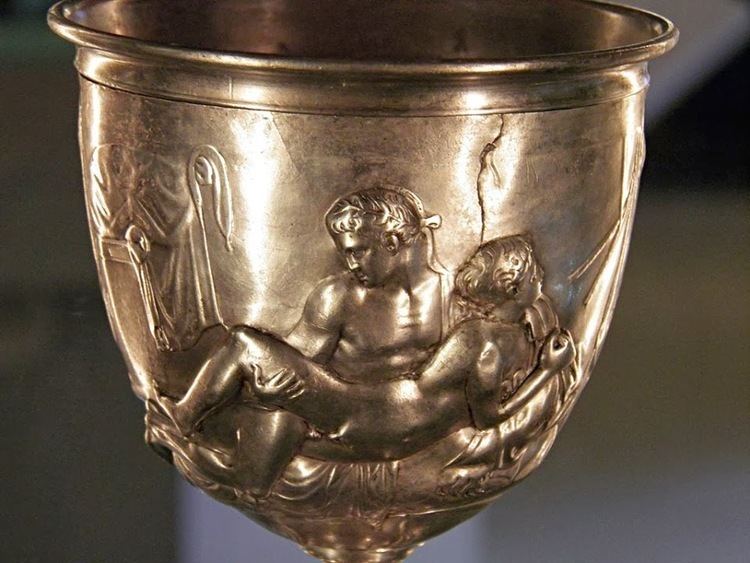
Imagery
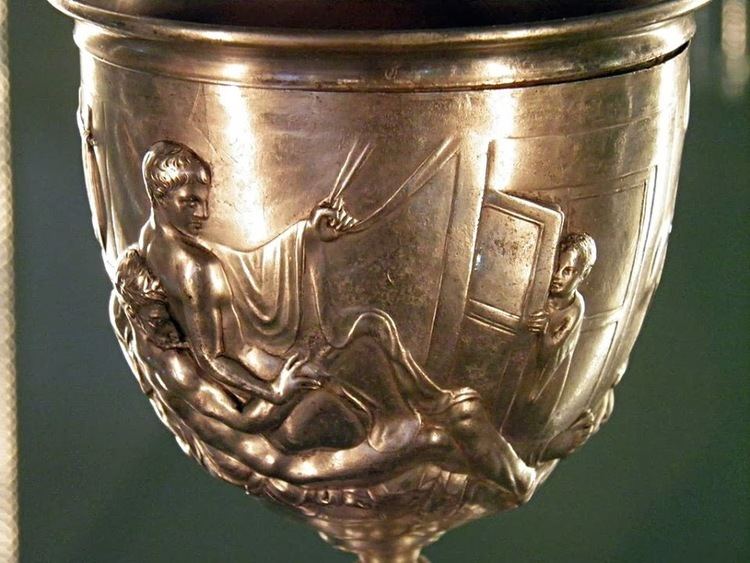
Representations of sexual acts are widely found in Roman art, although surviving male-female scenes greatly outnumber same-sex couples. It cannot be assumed that homoerotic art was uncommon as the modern record may be biased due to selective destruction or non-publication of pederastic works in later times. Illustrated drinking cups, often in pairs, were intended as dinner-party conversation pieces. Roman artwork on pottery, glass and wall-paintings with sexual acts represented were popular and were intended to be seen by all sections of society. The Romans had no word for homosexuality and the images on the Warren Cup provide an important insight into this aspect of their culture.

One side of the Warren Cup depicts a "bearded man" and a "beardless youth" engaging in anal sex in a reclining position, with the youth lowering himself using a strap or sash to be penetrated. A boy watches from behind a door. The two figures do not appear to be a great difference in age and are of a similar size. The apparent weight of the upper figure, as he lowers himself onto his lover's penis using the support, makes this a non-traditional passive role. The use of a strap or support during sex can be found in other Greek and Roman artworks, a close example being an erotic cup by Onesimos where a woman spreads her legs in anticipation while grasping a strap with her left hand.
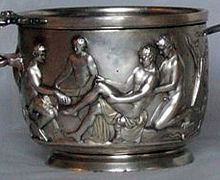
The other side depicts another scene of anal sex, between a "beardless" and clean-shaven "young man" and a smaller figure with long hair indicating he is a "boy" or "adolescent" (now the "eromenos"). The boy's hairstyle is typical of the puer delicatus, a servant-boy or cup or armour bearer. Roman same-sex practice differed from that of the Greeks, among whom pederasty was a socially acknowledged relationship between freeborn males of equal social status. Roman men, however, were free to engage in same-sex relations without a perceived loss of masculinity only as long as they took the penetrative role and their partner was a social inferior such as a slave or male prostitute: the paradigm of "correct" male sexuality was one of conquest and domination. There are significant differences to pederastic scenes found on classical Greek vases. The sex act is presented in graphic detail, and the boy appears to encourage the penetration, grasping his lover's arm. In Roman artwork there is an assumption that the penetrated youth is a slave or prostitute and on the Warren Cup, a mutual tenderness is represented.

Both scenes show draped textiles in the background, as well as a cithara (appearing as an eleven stringed lyre, often symbolic of pleasure and drinking parties) in the former scene and tibiae (reeded pipes) with finger holes being depicted in the latter. These, along with the careful delineation of ages and status and the wreaths worn by the youths, all suggest a cultured, elite, Hellenized setting with music and entertainment.
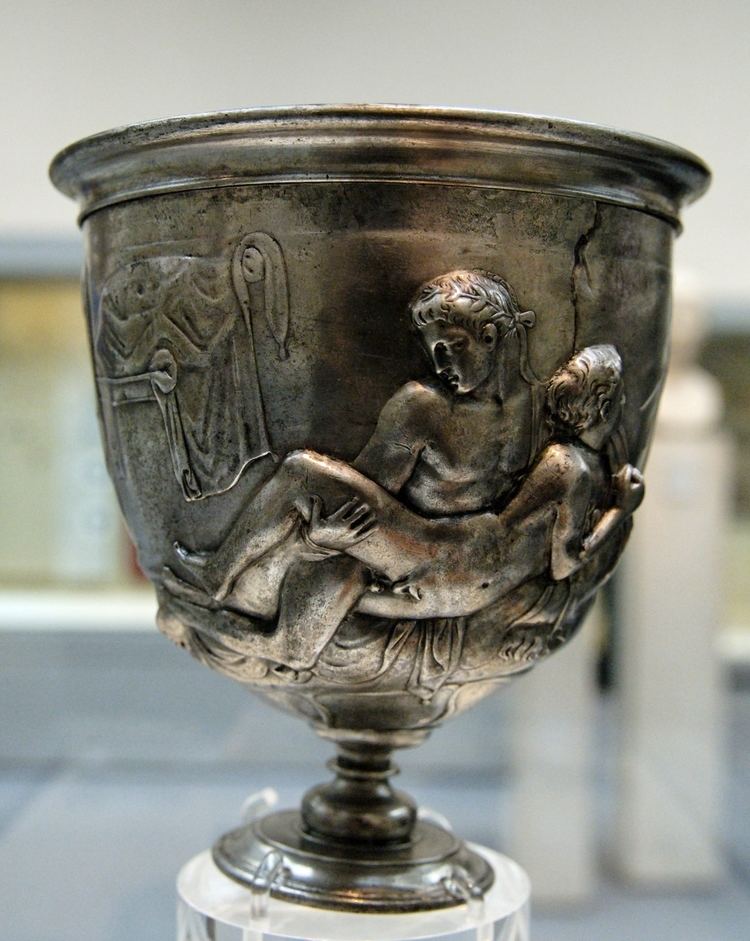
The active partners in the two sexual depictions are wearing leaf crowns, likely to be symbolically made from myrtle. Myrtle is an evergreen shrub, grown in the Roman period for medical and ritual purposes, such as weddings, and dedicated to Venus, the Roman goddess of sexuality and love. It has a smaller leaf than the more commonly depicted laurel. Myrtle was used to create the corona ovalis, a military crown awarded as an ovation but a far lesser award than the insignis corona triumphalis, one interpretation of the use of myrtle crowns on the Warren Cup, being a visual pun of homosexual penetration as an easy victory.
Modern provenance

Warren purchased the cup in Rome from a dealer in 1911 for £2,000. It was bought in Jerusalem and said to have been found near the city in Battir (ancient Bethther), with coins of the emperor Claudius, possibly buried during the upheavals of the Jewish Revolt.
We don't know for certain, but it's thought that the Warren Cup was found buried at Bittir, a town a few miles south-west of Jerusalem. How it got to this location is a mystery, but we can make a guess. We can date the making of the cup to around the year 10. About 50 years later, the Roman occupation of Jerusalem sparked tensions between the rulers and the Jewish community, and in AD 66 that exploded and the Jews took back the city by force. There were violent confrontations, and it is thought that our cup may have been buried at this date by the owner fleeing from the fighting.
The cup became a prized item in Warren's large art collection, referring to it with friends as the "Holy Grail". The first publication featuring the cup was in 1921, when Gaston Vorberg published a volume of 113 plates of erotic artwork from ancient artefacts. The photographs show the cup in an uncleaned state. The cup was included in Warren's book "A defence of Uranian Love", first published in 1928 under his pseudonym of Arthur Lyon Raile.
On Warren's death in 1928, the cup became part of the inheritance for Asa Thomas, Warren's male secretary and eventual business partner. It was part of the auction of the contents of Lewes House in 1929, but failed to sell and stayed hidden away in Thomas' attic. The cup was sent for cleaning after the Lewes House auction and photographs taken of the cup in 1931 show that it had been cleaned before that year.
In November 1952 Harold W. Parsons, an art historian and one of Warren's past companions, took responsibility for selling the cup and approached the New York collector Walter Baker, however Baker was hesitant to proceed. In February 1953 it was posted by Thomas to Walter Baker, however US Customs impounded the box requiring a decision from Washington to admit it as pornography, it was refused entry to the US on this basis and took until October 1954 to be returned to the UK, by which time Thomas had died. After this event, a number of museums declined to buy it. Thomas' widow sold the cup to the dealer John K. Hewett. Hewett offered the cup to Denys Haynes, Keeper of the Greek and Roman department at the British Museum who then sought an opinion from his friend Lord Crawford, a trustee of the museum. However the decision went no further as they thought that they would never persuade the museum's trustees who were chaired by the Archbishop of Canterbury.
In 1966 the Cup was offered for sale at £6,000 and bought by a private collector abroad.
In 1998 it was removed from the Metropolitan Museum of Art and sold to a British private collector. The cup was then acquired by its present owner, the British Museum, in 1999 for £1.8 million, with funds provided by the Heritage Lottery Fund, National Art Collections Fund and The British Museum Friends, to prevent its going abroad again. This was, at that time, the most expensive single item ever acquired by the British Museum, and many times the price at which it had been offered to them in the 1950s.
Dating and authenticity
John Clarke, Professor in Fine Arts at the University of Texas at Austin, has approximated the dating of the cup with similarly styled objects found in Pompeii, due to the lack of archaeological context.
Dyfri Williams, previously the Keeper of Greek and Roman Antiquities at the British Museum, dated the cup to AD 5–15. Williams identified several factors supporting this dating. The silver alloy being 95% pure is consistent with other known Roman silver vessels, with silver from later periods having a far higher purity. Cracks in the cup retain chemical corrosion products which are symptomatic of age, remaining despite being cleaned twice during the 20th century. An EDX analysis showed that the corrosion was silver chloride. The decorative style and shape have a close parallel with many other vessels of the period, such as the Chryses kantharos and the closely matching figures of nude men on the Hoby skyphoi, discovered a decade after the Warren cup was first recorded.
In 2008, Maria Teresa Marabini Moevs argued in an article for Bollettino d'Arte that the Warren Cup is not in fact a Roman product of the early Imperial period, but rather was executed around 1900 by a gifted silversmith trained in the contemporary Liberty style, perhaps commissioned by the amateur archaeologist and dealer Fausto Benedetti (1874–1931), to meet what he knew to be the taste of his foreign client and friend Edward Perry Warren. Benedetti may have worked in collaboration with the Castellani brothers of Rome, who were leading goldsmiths in classical styles, and collectors and dealers in antiquities. Moevs, an authority on Roman pottery, claims that the images on the cup derive from fragments of several scenes on Greek and Roman ceramics, including some in the Castellani collection, which were combined and modified to create the scenes on the Warren cup. An appendix to that article by silversmith Claudio Franchi provides corroborating technical evidence.
Luca Giuliani, a professor of classical archaeology at Humboldt University, has argued that the Warren cup was likely to be a 20th-century fake, on the basis of the unique subject matter and several incoherences in the iconography. At a King's College seminar on 12 March 2014, where counter-arguments were put forward by Dyfri Williams, Giuliani conceded that, if the British Museum were to produce evidence for traces of silver chloride corrosion on the inner side of the cup's shell, this would be a decisive argument for the authenticity of the piece.
Manufacture and condition
The Warren Cup is an estimated 95% pure silver with some copper and trace amounts of lead and gold. It was made in five sections:
- the main bowl, which was hammered thin from inside and subsequently finished off from the outside to produce the figures in relief;
- a separate plain inner liner bowl of thicker sheet silver with a solid rim, to make the cup easier to use and to clean;
- a base in solid silver;
- a cast foot soldered to the base;
- two handles, now missing.
The cup is etched and pitted due to the effect of corrosive cleaning deposits; however, remnants of silver chloride and black silver sulphide survive in crevices. A crack runs from the rim, around the figure of the boy on one side. The base is distorted and broken with the pedestal having been pushed up, denting the cup and causing the cup to lean at an angle. The damage to the base was in modern times, thought to have occurred when the cup was cleaned in the 20th century. The foot was soldered back on to the cup in modern times. It is thought that the cup was moulded twice in modern times due to remains of plaster and silicone rubber found in crevices.
Exhibition history
During the 1920s, Warren lent the cup to the Martin von Wagner Museum in Wurzburg.
In 1985 through to 1991 the Warren Cup was on loan and on display by the Antikenmuseum Basel und Sammlung Ludwig, Basel. From 1992 to 1998, the cup was put on display at Metropolitan Museum of Art in New York as an anonymous loan.
It was the subject of a devoted exhibition in Room 3 at the British Museum from 11 May to 2 July 2006, entitled "The Warren Cup: Sex and society in ancient Greece and Rome."
We wanted to show this fantastic object in a context in which we could ask how much we understand about attitudes to sexuality when it was made. These objects seem extraordinary to us now, but there were many objects in common use, and wall paintings and mosaics in baths and in private houses, showing very similar imagery.
From December 2006 to January 2007 it was exhibited at the Yorkshire Museum. The Warren Cup is the 36th object in A History of the World in 100 Objects, a BBC Radio 4 series first broadcast in 2010. In 2011 (January to April) it was loaned to Nottingham University for an exhibition in the Weston Gallery titled "Roman Sexuality: Images, Myths and Meanings."
In 2012 the cup was exhibited at Plymouth City Museum and Art Gallery in a LGBT "Pride in Our Past Exhibition".
An exhibition on the Isle of Wight on "Roman Sexuality: Images, Myths and Meanings" featured the cup in February to July 2014, at the Brading Roman Villa.
Replicas
Due to his interest in the cup, Warren had a replica made for John Beazley. The replica was donated to the Ashmolean Museum, Oxford as part of the Beazley Gift in 1966. The replica became a prominent feature in an exhibition at the museum in 1985.
There are six known replicas of the original Warren Cup. In April 2014, a copy owned by an anonymous private collector in Cape Town, South Africa, was stolen.
